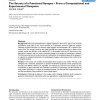508 search results - page 97 / 102 » A graphical model for protein secondary structure prediction |
COGSR
2011
13 years 4 months ago
2011
We simulate the evolution of a domain vocabulary in small communities. Empirical data show that human communicators can evolve graphical languages quickly in a constrained task (P...
IPPS
2008
IEEE
14 years 3 months ago
2008
IEEE
Graph structure can model the relationships among a set of objects. Mining quasi-clique patterns from large dense graph data makes sense with respect to both statistic and applica...
BMCBI
2006
13 years 9 months ago
2006
Background: Neuronal communication is tightly regulated in time and in space. The neuronal transmission takes place in the nerve terminal, at a specialized structure called the sy...
BMCBI
2004
13 years 9 months ago
2004
Background: Multiple sequence alignment algorithms are very important tools in molecular biology today. Accurate alignment of proteins is central to several areas such as homology...
BMCBI
2006
13 years 9 months ago
2006
Background: The relationship between disease susceptibility and genetic variation is complex, and many different types of data are relevant. We describe a web resource and databas...

